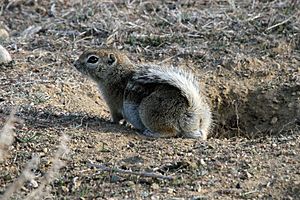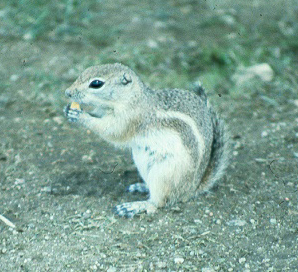San Joaquin antelope squirrel facts for kids
Quick facts for kids San Joaquin antelope squirrel |
|
|---|---|
 |
|
| Conservation status | |
| Scientific classification | |
| Genus: |
Ammospermophilus
|
| Species: |
nelsoni
|
The San Joaquin antelope squirrel, also known as Nelson's antelope squirrel (Ammospermophilus nelsoni), is a type of antelope squirrel. It lives in the San Joaquin Valley in the state of California, USA.
Contents
- Where Do San Joaquin Antelope Squirrels Live?
- What Do San Joaquin Antelope Squirrels Look Like?
- Squirrel Groups and Home Areas
- What Do San Joaquin Antelope Squirrels Eat?
- How Do San Joaquin Antelope Squirrels Behave?
- What Threats Do San Joaquin Antelope Squirrels Face?
- How Are We Helping San Joaquin Antelope Squirrels?
Where Do San Joaquin Antelope Squirrels Live?
The San Joaquin antelope squirrel lives in the San Joaquin Valley. This includes the slopes and ridge tops along the western edge of the valley. These squirrels are endemic to this area, meaning they are only found there. Sadly, they now live in a much smaller area than they used to.
A lot of the San Joaquin Valley has been turned into farmland. This means the squirrels have lost their homes. Also, people have used poisons to control rodents, which has hurt the squirrel population. Because of these problems, the San Joaquin antelope squirrel is now listed as a threatened species.
Most of the remaining San Joaquin antelope squirrels live in the Carrizo Plain. Here, their natural home is still safe. These squirrels live in small family groups underground. They prefer sandy, grassy areas that are easy to dig in. You can find them in isolated spots in San Luis Obispo and Kern Counties. Plants like Atriplex and Ephedra, and some junipers, often grow where these squirrels live. The scientific name of this squirrel honors an American nature expert named Edward William Nelson.
What Do San Joaquin Antelope Squirrels Look Like?
Physical Features
The San Joaquin antelope squirrel is a dull yellowish-brown color on its back and the outside of its legs. Its belly is white. It also has a white stripe down each side of its body, just like other antelope squirrels. The underside of its tail is a buffy white with black edges. Male squirrels are about 9.8 inches long. Females are a bit smaller, around 9.4 inches long.
Reproduction and Life Cycle
Studies show a lot about how Nelson's antelope squirrels breed. They mate in late winter to early spring. Most of their babies are born in March. After mating, the mother is pregnant for a little less than a month. The baby squirrels do not come out of their dens until about the first week of April. Nelson's antelope squirrel only has one breeding season each year. This timing is perfect because the babies are born when there is plenty of green food available.
How They Grow
Baby squirrels likely start or finish weaning (stopping milk feeding) before they even come out of their dens. Once they are above ground, young squirrels look for food by themselves. During weaning, the mother squirrel eats alone. She ignores her young if they try to nurse from her. Sometimes, a mother will even sleep in a different den if needed.
By early to mid-May, the young squirrels have had their baby fur for a while. They then start to change into their adult fur. By summer, they have their full adult fur. Once a squirrel is an adult, it is hard to tell how old it is. Nelson's antelope squirrels usually do not live for more than a year. However, some have been seen living for more than four years in the wild.
Squirrel Groups and Home Areas
Squirrel groups usually have about six to eight individuals. However, these squirrels are not spread out evenly across their home area. There is usually about one squirrel per hectare (about 2.5 acres). Nelson's antelope squirrel likes deep, rich soil. This type of soil is easy to dig through in both winter and summer.
Even though these squirrels dig for food, they do not make their own burrows. Instead, they use burrows that have been left empty by Dipodomys (kangaroo rats). Both male and female squirrels have the same size home area, which is about 4.4 hectares (about 11 acres). Of course, they spend most of their time in certain parts of this area.
What Do San Joaquin Antelope Squirrels Eat?
The San Joaquin antelope squirrel eats both plants and animals. It eats seeds, green plants, insects, and dried animal matter. Sometimes, it will hide food for later. Plants like redstem fialree (Erodium cicutarium) and brome grass (Bromus rubens) are important foods for these squirrels.
Their diet can change depending on the time of day or year. Green plants are the most common food from December to mid-April. This is because green plants are most plentiful then. Similarly, insects make up more than 90% of their diet from mid-April to December. This is when insects are more common.
Even though seeds are available most of the year, squirrels prefer insects or green plants. They will choose these over seeds, even if seeds are easier to find. Some people think this is because insects and green plants have more water. This water would be very important for squirrels to survive in a hot, dry place. There is not much water nearby for the Nelson's antelope squirrel. In labs, squirrels drink water easily. But they can also live for at least 7 months in the shade without water. After 7 months, they still look healthy.
How Do San Joaquin Antelope Squirrels Behave?
Nelson's antelope squirrels are social animals. If they are taken from their home and let go in a new place, they seem lost. They do not use a lot of energy during the day. This is because of the very hot temperatures where they live. In direct sunlight, a temperature of 31-32 °C (about 88-90 °F) can kill them. So, the squirrels are not very active during the hottest part of the day.
There is no proof that they hibernate (sleep through winter). But the squirrels are not bothered by the cold. They can survive temperatures below freezing in their burrows. They do not wake up very early. They are usually not seen until after sunrise. However, they do look for food in the morning and evening, avoiding the midday heat. Around noon, the squirrels go into their burrows. They are not seen again until about 2 pm at the earliest. On cooler days, squirrels will take their time looking for food. But on hot or cold days, they quickly bring as much food as possible back to their burrows.
Squirrels also like to stretch out and roll in the dust on the ground. These "dust baths" seem very fun for the squirrels. They might also help prevent tiny bugs from living on them.
Nelson's antelope squirrels are careful when they come out of their burrows. They follow a specific path when they look for food. If they sense danger, they will run into a burrow along their path to be safe. They move quickly and do not stay in one place for long. They are picky about what they eat. They rarely even waste time picking up food they are not interested in.
Besides moving fast, other things help keep them safe. The whitish color on the underside of their tail can be seen when they run. The squirrels will curl their tail forward over their back. They flick and twitch it back and forth as they run. This movement can make it look like a piece of fluff blowing in the wind. This might make predators ignore them.
To help avoid being caught, the Nelson's antelope squirrel has an alarm call. These calls are not loud. They are made with quick body movements. Other birds, like horned larks and white-crowned sparrows, also help spot predators. Squirrels will listen to the alarm calls these birds make.
The badger (Taxidea taxus) is a main predator of Nelson's antelope squirrels. Badgers will destroy burrows to get the squirrels. Coyotes (Canis latrans) and San Joaquin Valley Kit Fox (Vulpes macrotis mutica) also eat squirrels. But squirrels are not a main part of their diet.
What Threats Do San Joaquin Antelope Squirrels Face?
More and more farmland and city growth are big problems for Nelson's antelope squirrels. These squirrels will not live on farmed land. So, as more land is farmed, they lose their homes with no other place to go. Farm animals grazing also destroy the homes that are left. Also, plants that are not native to the area can take over the native grasses. The squirrels eat these native grasses and use them for shade and cover.
Pesticides from nearby farms can also drift onto the squirrel's home areas. These problems are not just hurting Nelson's antelope squirrel. They are also causing problems for other native animals and plants in the San Joaquin Valley. Native plants like the kern mallow, San Joaquin woolly threads, California jewelflower, and Bakersfield cactus are all endangered. They are being pushed out by plants that are not native. Many non-native plants grow in very thick patches. These thick patches are not good homes for Nelson's antelope squirrel or many other San Joaquin Valley species.
How Are We Helping San Joaquin Antelope Squirrels?
People have tried to control the non-native plants and other human-caused problems that hurt species in the San Joaquin Valley. One way to control non-native plants is by using controlled burns. However, this can also kill native plants and can be expensive. Studies are also being done to see how farm animals grazing affect the land. This helps create plans to reduce the impact. Some suggest using controlled grazing to help reduce the growth of non-native species in the valley.
Other ways to control problems include using chemicals and machines. But these can also take a lot of time and money, especially for large areas. Also, using herbicides (weed killers) could hurt species in the San Joaquin Valley if strong winds spread the chemicals. The U.S. Fish and Wildlife Service (USFWS) has a plan from 1998. This plan includes using Safe Harbor Agreements (SHAs) under the Endangered Species Act. This could help the USFWS work with farm landowners. Together, they can find the best way to manage the endangered species in the valley.
It is important to protect many species at once. This is because more and more native species in the San Joaquin Valley are becoming threatened or endangered. Managing the whole ecosystem would mean considering the role of all species. Also, teaching the public more about the valley could help get more money for protection plans. We need to keep watching and studying the squirrels. This will help us know how threatened they are and what needs to be done to bring their numbers back up.
Sadly, most information about Nelson's antelope squirrel talks about the problems it faces. It does not give much hope for its recovery. Even in 1918, experts believed it was only a matter of time before the species became extinct.



